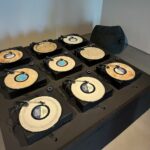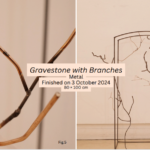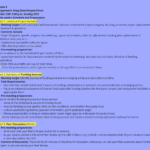One of the biggest issues with my presentation was poor time management. I originally planned to finish within five minutes, but I spent too much time on the background, which left me rushing through the actual exhibition details. While background information is important, it should not dominate the first half of my presentation. I realized that the audience cares more about the exhibition itself rather than why I created it, so in my next presentation, I will condense the background to about 30 seconds and focus more on explaining the core aspects of my exhibition.
The feedback from my group members and the professor also gave me valuable insights. My group members found my exhibition concept very interesting, but they felt the details were not clear enough, especially regarding how the exhibition would be set up, how visitors would experience it, and what kind of interactive elements were included. The professor pointed out that I need to control my pacing better and make sure the key aspects of the exhibition stand out instead of being rushed. To address these issues, I plan to enhance the visual representation of my exhibition in the next presentation. I will use a more structured and visually appealing PowerPoint, including layout sketches and exhibition flow diagrams, so that my curatorial ideas are easier to understand.
Watching my peers’ presentations also gave me some valuable takeaways. Some of them had very clear structures, where they introduced the exhibition concept in one sentence and then divided their explanation into key sections, making it easy to follow. Others used storytelling techniques to immediately immerse the audience in the atmosphere of their exhibition. This made me realize that I could replace my long background explanation with a short narrative or case study to introduce my topic in a more engaging way. Additionally, the use of visuals in presentations was crucial—some of my peers barely used text on their slides but instead relied on large images that complemented their speech. I will try to minimize text on my slides and rely more on visuals to make my exhibition ideas more compelling.
For my exhibition itself, I plan to study some well-known curatorial strategies. For example, I will look at Tate Modern’s immersive exhibitions to understand how they use light and space, the Metropolitan Museum’s exhibitions on death and mourning to see how they use historical artifacts to tell stories, and the Venice Biennale’s curatorial approaches to ensure my exhibition has a cohesive narrative. These references will help me refine my exhibition layout and consider adding interactive installations, light transitions, or sound elements to make the experience more immersive for visitors.
Moving forward, my key improvement areas are:
1.Refining my presentation structure—shortening the background and focusing on the exhibition content.
2.Enhancing visual representation—adding exhibition layout sketches and interaction diagrams for better clarity.
3.Strengthening interactive elements—creating more engaging visitor experiences, such as a memory wall or sensory interaction zones.
This experience has given me a clearer understanding of my weaknesses and inspired new ideas. I will incorporate these improvements into my next curatorial presentation, making my exhibition concept more complete and my communication more effective.





Julie Louise Bacon
10 March 2025 — 09:08
Hi Haonon, you mention the choice of “Inspiration” as the name of the curatorial group, it’s interesting to hear about but only one idea, and not the final name Terra Obscura: it’s important to give overviews and synthesis of activities, so the Blog does not have a patchwork/fragmented feel. When you discuss your curatorial concept you mention “Inspired by contemporary curatorial discussions on collaboration, self-expression, and liminal spaces” but do not support this with any references or examples, it is crucial to do this to communicate fully what you mean and to demonstrate the depth of your research and thinking. I think your exploration of the cultural reception of death is really interesting and your poetic/metaphysical reflections on it as transformation, could you have themed sections, with this as one of them, with some themes having cross-cultural significance others more culture focused? You could have colour zones too perhaps, difficult to say if this would work without knowing the artworks. I read with great interest your commentaries on death in Chinese culture. In terms of the memory wall and the interactive digital archive, there’s lots to consider here in terms of management, ethics and costs, as well as creating meaningful ways people could interact with this given the subject is so serious. It’s very good to hear how your fieldwork to Petra Bauer’s show influenced your thinking and expanded your idea to collective memory. The MAJOR thing missing from your project work is actual artistic/creative practices (I make the distinction because you could use other fields like poetry in tandem with visual art). It’s crucial you interconnect conceptual thinking with artistic research. The field trip this week had so much relevant content to your project (Maud Suter, specific artworks in the venues directly dealing with death), it’s important to review your notes/documentation of this as soon as possible to help this process. It’s good to see you mention plans to address feedback, but Tate and Metropolitan Museum (and Biennials) are the type of mega events we discussed in Week 1 and Week 2 which are less the focus for emerging curators than SVAOs models of practice. Did you visit Corpse Flower? The exhibition mentions death so clearly relevant to your thinking: liaise with someone in your Collective if not to update yourself, and also remember it is crucial to successfully completing this assessment to reflect your collective activities.
Your peer review of Shumiao and Chuni show lots of positive comments on the content, which make it clear you have engaged well with the Blogs, well done. I agree that Shumiao’s rejection of the ideas of “reducing individuals to mere “victims,” it positions silence itself as a form of resistance” is subtle and nuanced. It is also important to add suggestions of content/research as well, in relation to specific points. The question while relevant could be more focused, perhaps with examples of analyses of time in exhibition making/audience experiences, as a prompt. When discussing Chuni’s blog you raise lots of questions about artworks that are relevant to your own thinking: hopefully doing this peer review revealed the need to advance your own work in key areas.
CURATORIAL PITCH SLIDES
Your presentation covered some basic components of the project but was under-developed when compared with many of your peers and lacked substance (both practice and theory). Moving forward, as I mention above, it is crucial to approach this in a more tangible way, with the content informing your thinking. This is such a large theme, that there are many exhibitions that can fuel your thinking and offer examples of methods and perhaps artworks: finding art will also clarify to you the key curatorial narratives you can use for the show, whether you have sections or not, how you connect the inter-cultural aspects, colour, different meanings or contradicitons even of death. At the moment these are quite abstract threads. While I have mentioned budget, prodution planning and other practical elements for some students, you will have to anchor your project in artworks before you get to this. Then, thinking more about how you can engage the public through materials you create, which audiences you are aiming at (do you create different sets of materials). Exhibition design and layout based on professional examples you have identified will also be important: in Glasgow we saw a lot of different lighting strategies (light and colour go together to create impact, and light clearly has parallels with narratives of death) and uses of video installation or other media space in larger projects that could be relevant to you.